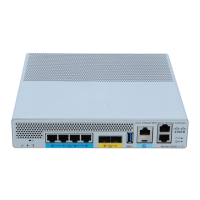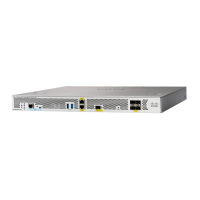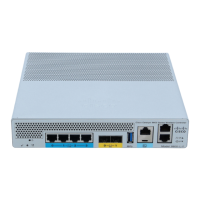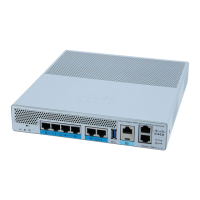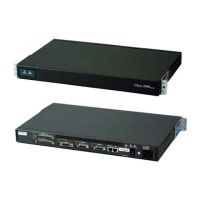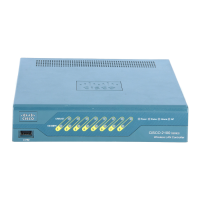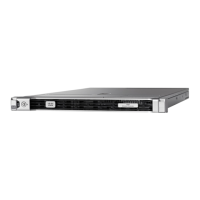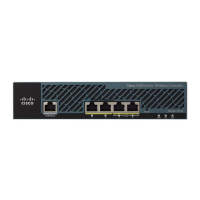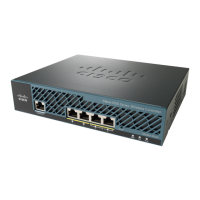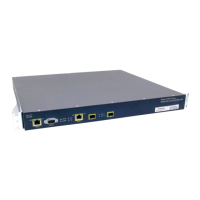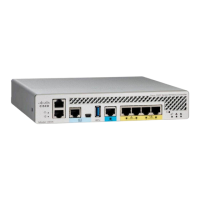Do you have a question about the Cisco Catalyst 9800-80 and is the answer not in the manual?
Provides a history of changes made to the document.
Outlines the purpose of the publication for installing the controller.
Describes the intended readers and their required experience for the guide.
Explains typographical conventions used in the document.
Lists other Cisco documentation for the controller.
How to get Cisco documentation and submit service requests.
Features and specifications of the Cisco Catalyst 9800-80 Wireless Controller.
Illustrates and describes the front panel of the wireless controller.
Describes port numbering and functionality for built-in SFP/SFP+ ports.
Shows management and storage connections on the controller.
Explains front panel LEDs and their behavior.
Standard for identifying Cisco products and services.
Explains the Unique Device Identifier (UDI) as a product ID standard.
Shows the locations of serial number and PID/VID labels on the controller.
Lists supported Ethernet Port Adapters (EPAs) for the controller.
Lists supported SFP and QSFP models for the wireless controller.
Details supported SFP, SFP+, and CPAK optical transceiver types.
Describes the supported crypto module for the controller.
Discusses AC and DC power supply options and hot-swappable nature.
Explains LEDs for AC power supply conditions.
Describes the function of power supply fans for cooling.
Recommendations and checks before starting installation.
Checklist for site planning and general safety guidelines.
Safety recommendations and NEBS compliance statements.
Explains numbered warnings and their definitions.
Lists general safety warnings relevant to installation.
Basic guidelines for working with electrical equipment and safety.
Guidelines for chassis lifting, tools, and unpacking.
Procedures for checking shipping contents and installation checklist.
Supported installation methods for the controller.
Guidelines and steps for shelf or tabletop installation.
Guidelines for installing the controller in various rack types.
How to measure rack dimensions for compatibility.
Procedure for attaching front rack-mount brackets to the chassis.
Securing the chassis to rack posts using brackets.
Step-by-step guide for installation in a two-post rack.
Instructions for mounting cable management brackets.
Chassis ground connection and recommended tools.
Guidelines for connecting external cables to the controller.
Connecting a console terminal via RJ-45 and USB ports.
Connecting the management Ethernet port to a network.
Ensures components are ready before powering up.
Step-by-step guide to power on the controller.
Guides initial controller configuration using setup facility.
Performing initial configuration via command-line interface.
Setting controller hostname and enable passwords.
Configuring timeout for privileged EXEC sessions.
Default configuration and setting IP addresses for Gigabit interfaces.
How to save the running configuration to NVRAM.
Verifying initial configuration and safely powering off.
Monitors environmental conditions and reports system status.
How to monitor controller status using alarm LEDs and commands.
Details expected operating conditions and monitoring functions.
Discusses checking fan status and handling failures.
Lists commands for environmental status and system reports.
Explains how to use the `show inventory` command.
Explains how to use the `show platform` command.
Explains how to view controller load, memory, and CPU utilization.
Viewing hardware info via diag chassis eeprom detail command.
Checking Cisco IOS license level using show version command.
Viewing UDI and evaluation license features.
Removing and installing AC power supplies.
Removing and installing DC power supplies.
Instructions for connecting DC power supply input leads.
Removing/replacing USB stick and repacking the controller.
Provides detailed technical specifications for the controller.
Pinout details for management Ethernet and console ports.
Provides a history of changes made to the document.
Outlines the purpose of the publication for installing the controller.
Describes the intended readers and their required experience for the guide.
Explains typographical conventions used in the document.
Lists other Cisco documentation for the controller.
How to get Cisco documentation and submit service requests.
Features and specifications of the Cisco Catalyst 9800-80 Wireless Controller.
Illustrates and describes the front panel of the wireless controller.
Describes port numbering and functionality for built-in SFP/SFP+ ports.
Shows management and storage connections on the controller.
Explains front panel LEDs and their behavior.
Standard for identifying Cisco products and services.
Explains the Unique Device Identifier (UDI) as a product ID standard.
Shows the locations of serial number and PID/VID labels on the controller.
Lists supported Ethernet Port Adapters (EPAs) for the controller.
Lists supported SFP and QSFP models for the wireless controller.
Details supported SFP, SFP+, and CPAK optical transceiver types.
Describes the supported crypto module for the controller.
Discusses AC and DC power supply options and hot-swappable nature.
Explains LEDs for AC power supply conditions.
Describes the function of power supply fans for cooling.
Recommendations and checks before starting installation.
Checklist for site planning and general safety guidelines.
Safety recommendations and NEBS compliance statements.
Explains numbered warnings and their definitions.
Lists general safety warnings relevant to installation.
Basic guidelines for working with electrical equipment and safety.
Guidelines for chassis lifting, tools, and unpacking.
Procedures for checking shipping contents and installation checklist.
Supported installation methods for the controller.
Guidelines and steps for shelf or tabletop installation.
Guidelines for installing the controller in various rack types.
How to measure rack dimensions for compatibility.
Procedure for attaching front rack-mount brackets to the chassis.
Securing the chassis to rack posts using brackets.
Step-by-step guide for installation in a two-post rack.
Instructions for mounting cable management brackets.
Chassis ground connection and recommended tools.
Guidelines for connecting external cables to the controller.
Connecting a console terminal via RJ-45 and USB ports.
Connecting the management Ethernet port to a network.
Ensures components are ready before powering up.
Step-by-step guide to power on the controller.
Guides initial controller configuration using setup facility.
Performing initial configuration via command-line interface.
Setting controller hostname and enable passwords.
Configuring timeout for privileged EXEC sessions.
Default configuration and setting IP addresses for Gigabit interfaces.
How to save the running configuration to NVRAM.
Verifying initial configuration and safely powering off.
Monitors environmental conditions and reports system status.
How to monitor controller status using alarm LEDs and commands.
Details expected operating conditions and monitoring functions.
Discusses checking fan status and handling failures.
Lists commands for environmental status and system reports.
Explains how to use the `show inventory` command.
Explains how to use the `show platform` command.
Explains how to view controller load, memory, and CPU utilization.
Viewing hardware info via diag chassis eeprom detail command.
Checking Cisco IOS license level using show version command.
Viewing UDI and evaluation license features.
Removing and installing AC power supplies.
Removing and installing DC power supplies.
Instructions for connecting DC power supply input leads.
Removing/replacing USB stick and repacking the controller.
Provides detailed technical specifications for the controller.
Pinout details for management Ethernet and console ports.
| Model | Cisco Catalyst 9800-80 |
|---|---|
| Category | Controller |
| Product Type | Wireless LAN Controller |
| Form Factor | Rack-mountable |
| Rack Height | 2U |
| Wireless Standards | 802.11a/b/g/n/ac/ax |
| Maximum Number of Access Points | 6000 |
| Maximum Number of Wireless Clients | 64000 |
| Throughput | 80 Gbps |
| High Availability | Yes |
| Redundant Power Supply | Yes |
| Operating Temperature | 32 to 104°F (0 to 40°C) |
| Ports | 8 x 10 Gigabit Ethernet (SFP+) |
| Redundancy | N+1 |
| Management | Web UI, CLI |
| Power Supply | AC |
| Storage Temperature | -40°F to 158°F (-40°C to 70°C) |
| Humidity | 5 - 95% (noncondensing) |
